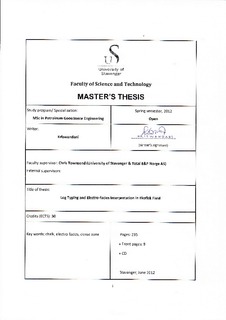| dc.description.abstract | Recognition of the dense zones in Ekofisk field is clearly observed from well logging through a specific peak in the neutron-density log. These zones appear to be intercalated in porous clean chalks in the middle part of the Ekofisk formation, at the border of the Ekofisk-Tor Formation and in the middle part of the Tor formation. The thick zone between the Ekofisk and Tor formation that is a so called tight zone is found continuously within the Central Graben basin. On the Ekofisk field, this zone is suspected to be a very good conductor for cold injected water compared to the clean porous chalk intervals. By recognizing these zones, a more integrated new well planning (completion and placement) together with the field development schemes to more efficiently drain the field is possible to implement.
Log responses of gamma ray and density that is combined with the values of Young’s Modulus and Poisson’s ratio from 5 wells (2/4-A-6, 2/4-B-19 A, 2/4-K-22, 2/4-K-4 and 2/4-X-32) are used to characterize the different chalk types within the Ekofisk field. These responses group the rock into 8 types, which comprise 3 types of tight clean chalk, 3 types of clay-contaminated tight chalk and 2 types of clean porous chalk. In a different scale, wells with mineralogy analysis links the electro-facies to the elements that may be responsible for the different chalk reservoir quality. The defined electro-facies in the Ekofisk and Tor formations have also been checked against data from core analysis and measurements of pressure, fractures and permeability to better characterize the physical properties of the electro-facies.
By the means of 72 wells completed with e-facies, the trend of dense zones in specific layers (EM2, EM4, EEU, EEM, EEL and TBU) is examined. A spatial analysis of each e-facies is performed in order to be able to extrapolate the facies distribution throughout the field. The resulting model is validated by using 3 blind-test wells, completed with electro-facies and core description, which not are accounted for in the modeling.
The result of the study is a map of facies proportion for each of the stratigraphic layers within the Ekofisk field and a facies model of certain stratigraphic layers. In the EM2 and EM4 layers, the pattern of lateral facies change can hardly be recognized qualitatively indicating a random-patchy facies distribution. In the EE layer, the facies population suggests an unsystematic lateral facies distribution. However, a distinct belt of more dense facies of East-West orientation can be demonstrated in the northern and southern areas of the Ekofisk field in the TBU layer. | no_NO |
